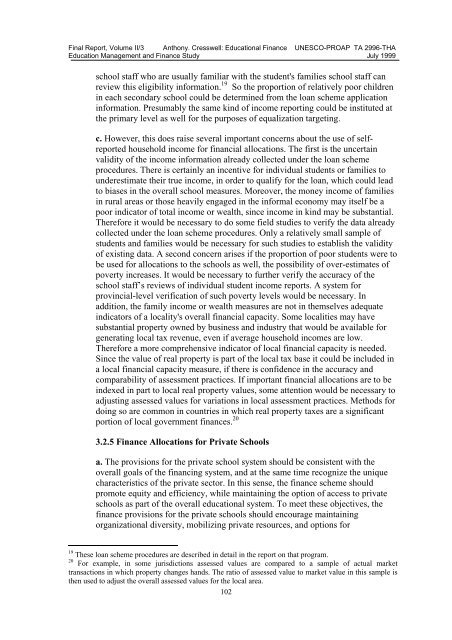Educational Finance in Thailand - UNESCO Bangkok
Educational Finance in Thailand - UNESCO Bangkok
Educational Finance in Thailand - UNESCO Bangkok
Create successful ePaper yourself
Turn your PDF publications into a flip-book with our unique Google optimized e-Paper software.
F<strong>in</strong>al Report, Volume II/3 Anthony. Cresswell: <strong>Educational</strong> <strong>F<strong>in</strong>ance</strong> <strong>UNESCO</strong>-PROAP TA 2996-THA<br />
Education Management and <strong>F<strong>in</strong>ance</strong> Study July 1999<br />
school staff who are usually familiar with the student's families school staff can<br />
review this eligibility <strong>in</strong>formation. 19 So the proportion of relatively poor children<br />
<strong>in</strong> each secondary school could be determ<strong>in</strong>ed from the loan scheme application<br />
<strong>in</strong>formation. Presumably the same k<strong>in</strong>d of <strong>in</strong>come report<strong>in</strong>g could be <strong>in</strong>stituted at<br />
the primary level as well for the purposes of equalization target<strong>in</strong>g.<br />
c. However, this does raise several important concerns about the use of selfreported<br />
household <strong>in</strong>come for f<strong>in</strong>ancial allocations. The first is the uncerta<strong>in</strong><br />
validity of the <strong>in</strong>come <strong>in</strong>formation already collected under the loan scheme<br />
procedures. There is certa<strong>in</strong>ly an <strong>in</strong>centive for <strong>in</strong>dividual students or families to<br />
underestimate their true <strong>in</strong>come, <strong>in</strong> order to qualify for the loan, which could lead<br />
to biases <strong>in</strong> the overall school measures. Moreover, the money <strong>in</strong>come of families<br />
<strong>in</strong> rural areas or those heavily engaged <strong>in</strong> the <strong>in</strong>formal economy may itself be a<br />
poor <strong>in</strong>dicator of total <strong>in</strong>come or wealth, s<strong>in</strong>ce <strong>in</strong>come <strong>in</strong> k<strong>in</strong>d may be substantial.<br />
Therefore it would be necessary to do some field studies to verify the data already<br />
collected under the loan scheme procedures. Only a relatively small sample of<br />
students and families would be necessary for such studies to establish the validity<br />
of exist<strong>in</strong>g data. A second concern arises if the proportion of poor students were to<br />
be used for allocations to the schools as well, the possibility of over-estimates of<br />
poverty <strong>in</strong>creases. It would be necessary to further verify the accuracy of the<br />
school staff’s reviews of <strong>in</strong>dividual student <strong>in</strong>come reports. A system for<br />
prov<strong>in</strong>cial-level verification of such poverty levels would be necessary. In<br />
addition, the family <strong>in</strong>come or wealth measures are not <strong>in</strong> themselves adequate<br />
<strong>in</strong>dicators of a locality's overall f<strong>in</strong>ancial capacity. Some localities may have<br />
substantial property owned by bus<strong>in</strong>ess and <strong>in</strong>dustry that would be available for<br />
generat<strong>in</strong>g local tax revenue, even if average household <strong>in</strong>comes are low.<br />
Therefore a more comprehensive <strong>in</strong>dicator of local f<strong>in</strong>ancial capacity is needed.<br />
S<strong>in</strong>ce the value of real property is part of the local tax base it could be <strong>in</strong>cluded <strong>in</strong><br />
a local f<strong>in</strong>ancial capacity measure, if there is confidence <strong>in</strong> the accuracy and<br />
comparability of assessment practices. If important f<strong>in</strong>ancial allocations are to be<br />
<strong>in</strong>dexed <strong>in</strong> part to local real property values, some attention would be necessary to<br />
adjust<strong>in</strong>g assessed values for variations <strong>in</strong> local assessment practices. Methods for<br />
do<strong>in</strong>g so are common <strong>in</strong> countries <strong>in</strong> which real property taxes are a significant<br />
portion of local government f<strong>in</strong>ances. 20<br />
3.2.5 <strong>F<strong>in</strong>ance</strong> Allocations for Private Schools<br />
a. The provisions for the private school system should be consistent with the<br />
overall goals of the f<strong>in</strong>anc<strong>in</strong>g system, and at the same time recognize the unique<br />
characteristics of the private sector. In this sense, the f<strong>in</strong>ance scheme should<br />
promote equity and efficiency, while ma<strong>in</strong>ta<strong>in</strong><strong>in</strong>g the option of access to private<br />
schools as part of the overall educational system. To meet these objectives, the<br />
f<strong>in</strong>ance provisions for the private schools should encourage ma<strong>in</strong>ta<strong>in</strong><strong>in</strong>g<br />
organizational diversity, mobiliz<strong>in</strong>g private resources, and options for<br />
19 These loan scheme procedures are described <strong>in</strong> detail <strong>in</strong> the report on that program.<br />
20 For example, <strong>in</strong> some jurisdictions assessed values are compared to a sample of actual market<br />
transactions <strong>in</strong> which property changes hands. The ratio of assessed value to market value <strong>in</strong> this sample is<br />
then used to adjust the overall assessed values for the local area.<br />
102

















